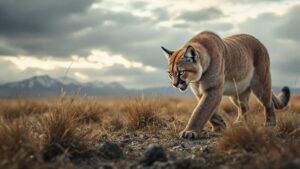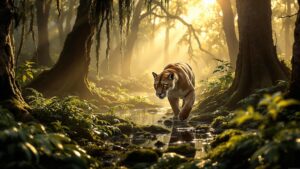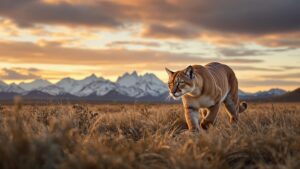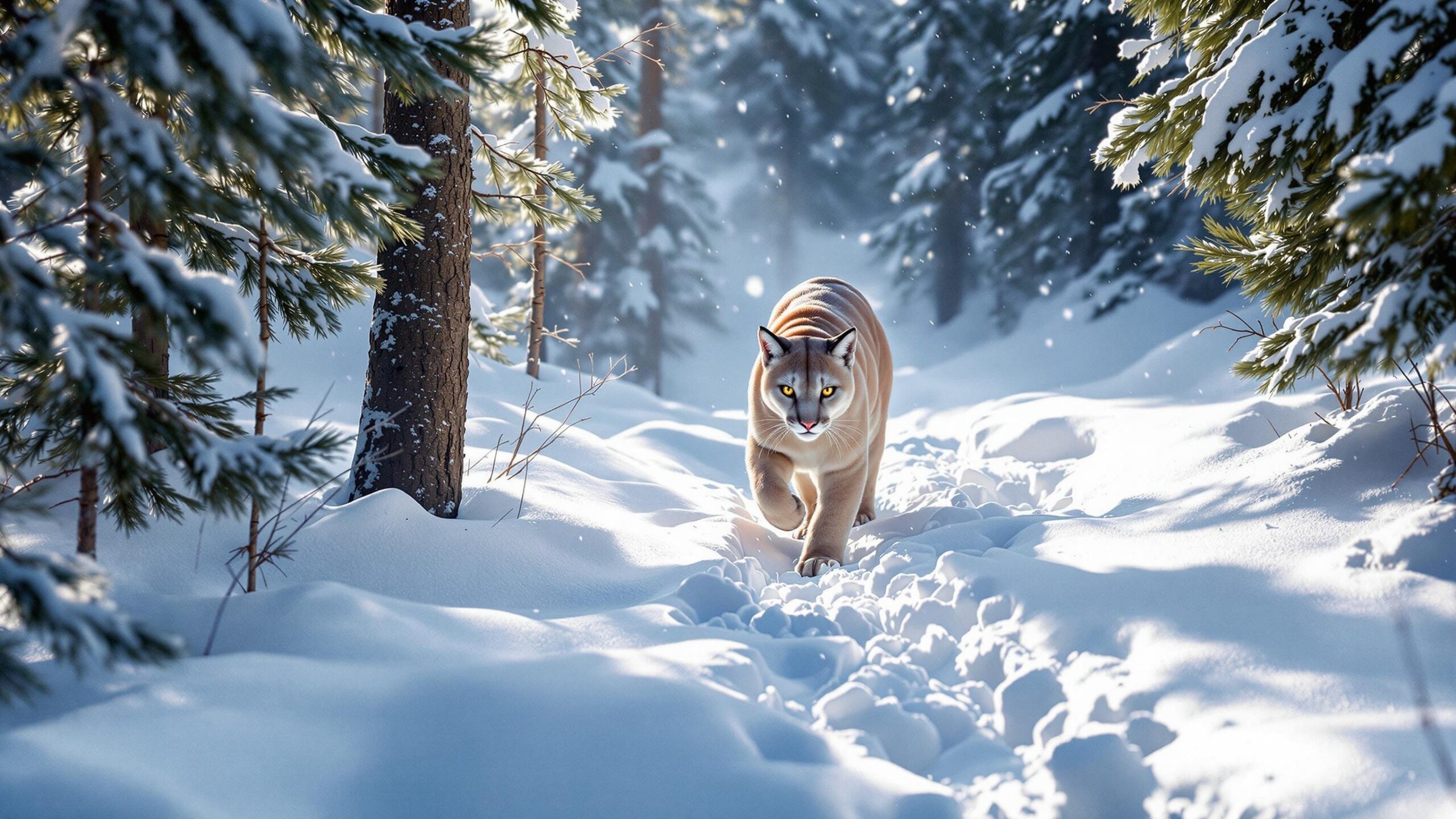Pumas, Cougars, Mountain Lions: The Secret Kings of the Americas
In the hush of twilight, as mountain shadows stretch long across the land, a silent hunter emerges. With a body built for stealth and agility, eyes sharp as stars, and muscles coiled beneath a sleek tawny coat, the puma—also known as the cougar, mountain lion, panther, or catamount—moves like a whisper through the wild. It is the most widespread big cat in the Western Hemisphere, a phantom of forests, deserts, plains, and peaks. Though not as famous as lions or tigers, the puma is one of the most successful and adaptable predators on Earth, and its story is one of resilience, mystery, and crucial ecological impact.
To understand the puma is to explore a world of stunning range and quiet dominance. Known scientifically as Puma concolor, this remarkable species weaves through North and South America with a grace that transcends terrain, climate, and even human encroachment. Unlike other big cats that roar, the puma purrs, chirps, hisses, and growls—communicating in ways as subtle as its movement. It is a creature of paradoxes: large but elusive, powerful but solitary, near and yet rarely seen.

Andean Puma
The Andean Puma: Silent Sovereign of South America’s Great Heights In the thin, chilled air above the clouds, where the peaks of the Andes scrape the sky and condors ride the wind, a majestic and elusive feline prowls the highlands with quiet confidence. The Andean puma, scientifically known as Puma concolor puma, is one of the most iconic and widespread apex predators in the mountainous spine of South America. Adapted

Florida Panther
The Florida Panther: Ghost of the Everglades In the sun-dappled shadows of cypress swamps and palmetto thickets, a rare and elusive feline moves with silent grace. Known scientifically as Puma concolor coryi, the Florida panther is a subspecies of the cougar, native only to the southeastern United States. Once roaming across the entire Gulf Coast and beyond, this mysterious predator now survives in the remote wilderness of southern Florida—a resilient

North American Cougar
The North American Cougar: Phantom of the Wilderness From the dense pine forests of the Pacific Northwest to the swamps of Florida and the rugged mountains of the Rockies, a silent and solitary feline stalks the wilds of North America. Known by many names—mountain lion, puma, panther, catamount, or cougar—this apex predator is scientifically classified as Puma concolor couguar, a subspecies of the widespread cougar species that once roamed from

South American Puma
The South American Puma: Ghost of the Andes and Guardian of the Wild Graceful, elusive, and commanding, the South American puma is a creature that has roamed the rugged and varied landscapes of the continent for millennia. Known scientifically as Puma concolor concolor, this large cat is one of the most widespread carnivores in South America. From the windswept plains of Patagonia to the dense Amazon rainforest and the towering
The Purr That Stalks the Mountains: Biology and Adaptability of Puma concolor
The puma stands apart in the feline family. Though it is the fourth-largest cat in the world—after tigers, lions, and jaguars—it belongs to a different lineage than the roaring Panthera genus. Pumas are closely related to smaller cats like the cheetah and domestic feline, and this ancestry is reflected in their lithe bodies, long tails, and vocal abilities. Adult pumas typically weigh between 80 and 220 pounds depending on sex and location, with a length that can stretch over 8 feet from nose to tail.
One of the puma’s most defining features is its range. Found from the Yukon in Canada to the southern tip of Chile, it holds the widest distribution of any wild land mammal in the Western Hemisphere. This extraordinary adaptability is key to its success. Whether traversing snowy mountain passes, arid deserts, humid rainforests, or suburban greenbelts, the puma adjusts its behavior, diet, and territory size with remarkable flexibility.
Pumas are obligate carnivores and apex predators. Their primary prey is ungulates like deer and guanacos, but they are opportunistic hunters that will take rabbits, raccoons, porcupines, and even insects when necessary. Solitary by nature, pumas maintain large home ranges and rely on stealth to stalk and ambush their quarry. Their muscular hind legs allow for explosive leaps of up to 40 feet, and their retractable claws and powerful jaws make them lethal hunters.
Mountain Lions of North America: Ghosts in the Wilderness
In the United States and Canada, the puma is most commonly known as the mountain lion. These cats once roamed coast to coast, but by the early 1900s, they had been eradicated from the eastern half of the continent. Thanks to protections and expanding prey populations, mountain lions are slowly reclaiming their former range.
Mountain lions thrive in diverse habitats across the western United States, from the pine forests of the Rockies to the deserts of Arizona. In California, they inhabit the Santa Monica Mountains—one of the only places in the world where large carnivores live within a major metropolitan area. Yet these populations are fragmented by highways and development, and urban encounters have sparked intense debate over coexistence.
These North American pumas are masters of solitude. Males may roam up to 150 square miles, overlapping with several female territories. They rarely vocalize and leave little trace, earning them nicknames like “ghost cat” or “shadow stalker.” Despite their stealth, GPS tracking and camera traps have illuminated their essential role in managing deer populations and maintaining trophic balance. Where mountain lions thrive, ecosystems flourish.
The Florida Panther: A Tale of Tragedy and Tenacity
Tucked into the southern swamps of Florida lies the most endangered puma population in North America—the Florida panther. This distinct population, genetically isolated and once nearly extinct, has become a flagship case for big cat conservation. In the 1990s, only about 20 Florida panthers remained, plagued by genetic defects from inbreeding, including kinked tails, heart problems, and low fertility.
To revive the population, eight female Texas cougars were introduced to Florida, bringing much-needed genetic diversity. The strategy worked. The population rebounded to around 200 individuals, though challenges remain. Florida panthers face constant threats from vehicle collisions, habitat loss, and territorial disputes. Urban sprawl continues to chip away at their fragmented refuge.
Despite these obstacles, the Florida panther has become a symbol of resilience and a model for wildlife corridor advocacy. Conservation efforts like the creation of wildlife underpasses and protected swamps are helping secure a future for these southern survivors. Their story demonstrates how proactive intervention, grounded in science, can turn the tide for an entire subspecies on the brink.
South American Pumas: Silent Lords of the Southern Hemisphere
South of the equator, pumas rule with quiet authority. In the Andes, Patagonia, and across much of South America, they are often called simply “puma” or “león.” These cats have adapted to some of the world’s most breathtaking yet unforgiving terrains—snowy peaks, volcanic slopes, and wind-blasted plains. In Chile’s Torres del Paine National Park, pumas have become global icons, with wildlife photographers and ecotourists flocking to capture their images. Unlike their northern cousins, these pumas are sometimes bolder, more visible, and occasionally active during the day. Their primary prey, the guanaco, is an agile relative of the llama, and pumas must use strategy and patience to bring one down.
In Argentina and Brazil, pumas must also navigate agricultural lands, dense forests, and sprawling ranches. Human-wildlife conflict is common, with ranchers viewing pumas as livestock threats. Yet cultural attitudes vary widely. In Andean mythology, the puma is a powerful totem of strength and protection, and in modern conservation circles, it is increasingly seen as a keystone species deserving respect and space.
Eastern Ghosts and Urban Shadows: The Reappearance of the Cougar
Though long thought extinct in the eastern United States, reports of cougars in states like Michigan, Wisconsin, and even Connecticut continue to surface. While most are attributed to escaped captives or wandering individuals from the west, these sightings highlight a tantalizing possibility: the slow, natural return of the cougar to its former eastern haunts.
Genetic evidence has confirmed dispersing males traveling over a thousand miles from South Dakota to the Midwest and beyond. These solitary pioneers face tremendous odds—crossing highways, avoiding cities, and surviving unfamiliar territory—but their presence signals the ecological possibility of range re-expansion.
In urban and suburban areas, pumas are also showing remarkable adaptability. In Colorado and California, mountain lions have learned to hunt silently in residential areas, sometimes triggering concern, but also prompting admiration. Public education, non-lethal deterrents, and land use planning are all part of the conversation as humans come to terms with living alongside big cats once again.
Pumas and People: Conflict, Coexistence, and Cultural Connections
The relationship between humans and pumas has been complex and evolving for centuries. In indigenous American cultures, the puma has often been a sacred figure, symbolizing courage, protection, and spiritual power. In Incan cosmology, the puma represented the earthly realm, standing between the heavens and the underworld.
In contrast, European settlers saw the cougar as a threat to livestock and personal safety. Systematic extermination campaigns in the 19th and early 20th centuries nearly wiped out pumas in much of North America. Today, attitudes are shifting. Ecotourism, scientific understanding, and renewed cultural appreciation are giving rise to more tolerant and even celebratory perspectives. Yet conflict remains. Livestock depredation, especially in South America and rural U.S. communities, can lead to lethal retaliation. Myths of pumas stalking people persist, though attacks are extremely rare. Education, fencing, compensation programs, and coexistence strategies are essential to balancing human needs with puma conservation.
The Ecological Role of Pumas in the Food Web
Pumas are apex predators and ecological architects. By preying on herbivores such as deer, elk, and guanacos, they help regulate population sizes and reduce overgrazing. This in turn allows vegetation to regenerate, benefiting entire ecosystems—from grasses to birds to pollinators. In areas where pumas have been reintroduced or allowed to return, researchers have documented cascading ecological benefits. In the Santa Cruz Mountains of California, pumas indirectly increased songbird diversity by controlling deer that were over-browsing saplings. In Patagonia, pumas help limit invasive hares, keeping native plants from being overwhelmed.
Pumas also play a role in the scavenger food chain. Their kills feed a host of other species—foxes, condors, eagles, and insects. In this way, even their leftovers serve life. Protecting pumas means maintaining biodiversity, ecological health, and resilience across vast landscapes.
Conservation Challenges and the Future of the Puma
Despite their wide range and adaptability, pumas are facing mounting pressures. Habitat fragmentation is one of the greatest threats, as roads, fences, and urban sprawl cut off genetic exchange and isolate populations. Roadkill is a leading cause of death in places like Florida and California. Another challenge is the lack of legal protection in many regions. While mountain lions are protected in some U.S. states, they are still legally hunted in others. In parts of South America, enforcement is weak, and pumas are killed without consequence. Poaching, retaliatory killings, and habitat degradation continue to chip away at their numbers.
Conservationists are working on multiple fronts. Wildlife corridors, overpasses, and protected areas are critical to ensuring puma populations remain viable. Genetic research is helping identify vulnerable populations, and community education is turning fear into understanding. Some of the most exciting efforts involve citizen science and technology. GPS collars, camera traps, and trail monitoring apps are empowering everyday people to contribute data and observations, deepening our collective knowledge and appreciation of this elusive predator.
Following the Tracks of the Wild and Wise
The puma is not just a predator. It is a story—of survival, of evolution, of deep ties to the land. From the Andean ridges to the Appalachian shadows, from Florida’s swamps to the snowy Canadian forests, pumas move quietly through ecosystems that still depend on them. They ask nothing from us but space, respect, and understanding. As we face a future shaped by climate change, population growth, and ecological uncertainty, the puma stands as a symbol of what still works in nature. It adapts, it endures, and it heals the wild places it inhabits. To protect the puma is to protect the land itself—and in doing so, protect something within ourselves that is still wild, still watchful, still free. Let this be your invitation. Explore their territories. Learn their signs. Trace their paths across maps and mountains. The cougar is out there, just beyond the next rise, still watching, still moving—still part of the great living story of the Americas.

